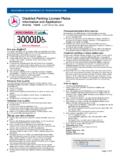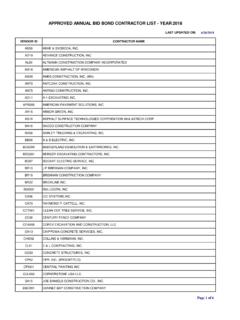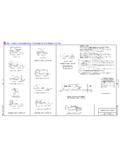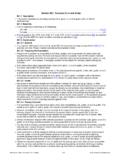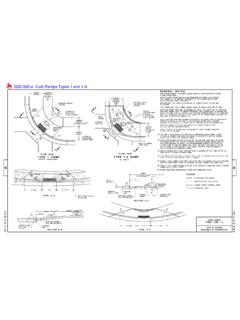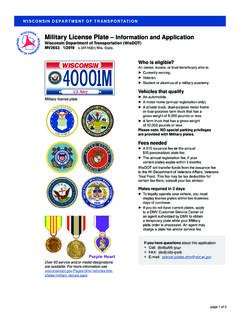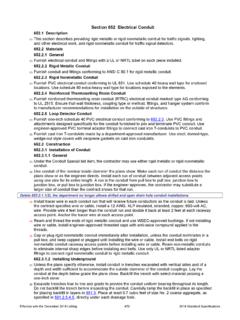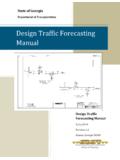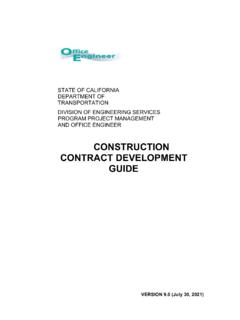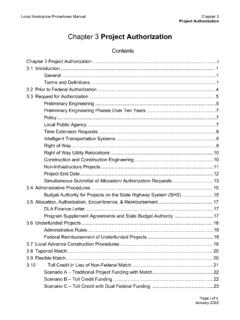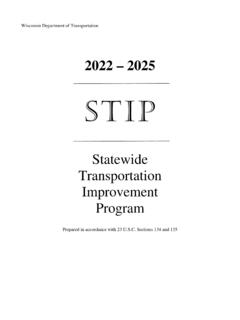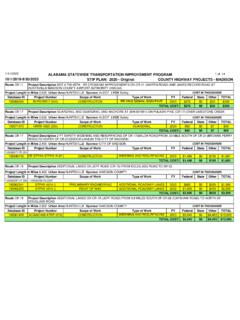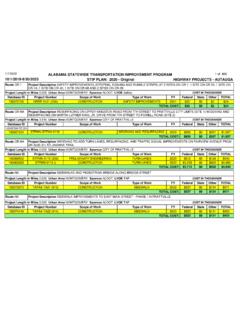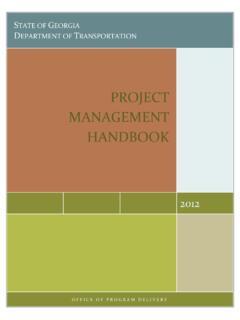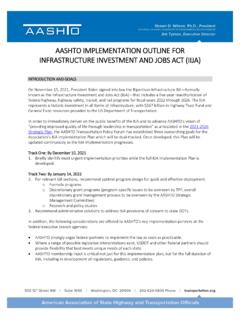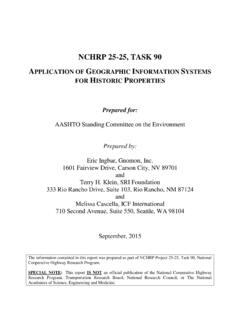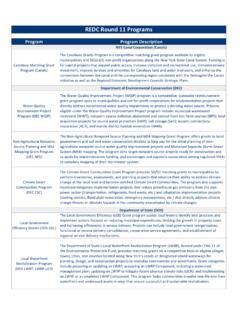Transcription of For the Local Roads Improvement Program (LRIP)
1 For the Local Roads Improvement Program (LRIP) 2022-2023 Program Cycle Program Overview .. 1 Program Objective .. 1 Acronyms .. 1 General Requirements .. 2 Program Administration .. 3 Project Review .. 4 Noncompliance and Appeals .. 4 Funding Distribution .. 4 Entitlement Distribution .. 5 Discretionary Distribution .. 5 LRIP-Supplemental (LRIP-S) .. 6 Program Flowchart .. 7 Program Timeline, Roles & Responsibilities .. 8 LRIPWeb .. 9 Access to LRIPWeb .. 9 Records Retention .. 9 New Biennium Project Applications .. 9 Application Submittal Deadline .. 9 Entering an Application .. 9 Funding Component Selection .. 10 Entitlement Components ..10 Discretionary Components ..10 CHID & CHIS Overview ..10 TRID & TRIS Overview .. 11 MSID &MSIS Overview .. 12 Project Improvement Types .. 15 Pavement Replacement ..15 Reconditioning.
2 15 Resurfacing ..15 Reconstruction ..16 Structure .. 16 Purchase Hot Mix Asphalt Only (option) .. 16 Project Costs .. 16 Eligible LRIP Project Costs ..16 Ineligible LRIP Project Costs .. 16 Project Selection Committees .. 17 (CTRIC) County Town Road Improvement TABLE OF CONTENTS (CMSIC) County Municipal Street Improvement Committee ..18 (CHIDC) County Highway Improvement District Committee .. 19 (STRIDC) Statewide Town Road Improvement Discretionary Committee ..20 (SMSIDC) Statewide Municipal Street Discretionary Improvement Committee .. 20 State Municipal Project Agreement (SMA) .. 20 Exception to Standards ..20 Sunset Policy ..21 Approved Project Options .. 21 Project Changes ..21 Project Substitutions ..21 Transfer of Funds ..21 Forfeit of Funds ..22 Project Savings .. 22 Advertising and Award .. 22 Advertising Purchase of Hot Mix Asphalt (HMA) Only.
3 23 Award Requirements .. 23 Contracting with a County ..24 Reimbursement Request Process .. 25 Engineer s Certification ..25 Cost Effectiveness Finding (CEF) ..25 Contact Information .. 27 County Highway Commissioner ..27 LRIP Program Manager ..27 LRIP Contract Specialist .. 27 Appendix A Wisconsin Statute Local Roads Improvement Program .. 28 Appendix B WI Chapter Trans 206 Local Roads Improvement Plan .. 30 Appendix C Chapter (3s) Wis Stats Authorizing LRIP-S .. 36 Appendix D WI Chapter Trans 205 County Trunk Highway Standards ..37 Appendix E WI Chapter Trans 204 Existing Town Road Improvement Standards .. 40 Appendix F WisDOT Facilities Development Manual FDM 11-20-1 .. 42 Appendix G CHI Entitlement Allocations .. 43 Appendix H TRI Entitlement Allocations .. 44 Appendix I TRI Programming Caps by County .. 45 Appendix J MSIGT Entitlement Allocations.
4 46 Appendix K MSILT Entitlement Allocations .. 47 Appendix L MSILT Programming Caps by County .. 48 Appendix M Discretionary & Supplemental Allocations .. 49 Appendix N Example of an Exception to Standards .. 50 Appendix O WisDOT Contacts for Requesting an Exception to Standards .. 51 Appendix P WDNR Transportation Liaison Staff .. 52 Appendix Q Project Checklist .. 55 Appendix R Example of an Advertisement and Affidavit of Publication ..57 Appendix S Example of an Engineer s Certification .. 58 Appendix T WCHA Districts Map .. 59 Appendix U Noncompliance and Appeals .. 60 Appendix V PASER Rating Table .. 62 Appendix W Project Selection Committee Flowcharts .. 63 1 Program OBJECTIVE The Local Roads Improvement Program (LRIP) was established in 1991 to assist Local units of government in improving seriously deteriorating county highways, municipal streets in cities and villages, and town Roads .
5 The Program is governed by s. , Wis. Stats., and ch. Trans 206. LRIP is a reimbursement Program , which may pay up to a maximum of 50% of total eligible project costs, with the balance of the eligible costs funded by the Local unit of government. All projects are advertised, awarded, managed and the contractors are paid in full by the project recipient prior to submittal of the reimbursement request to WisDOT. The Program has three entitlement components that provide funding for road improvements. Counties are eligible for funding through the County Highway Improvement (CHI) Program , towns through the Town Road Improvement (TRI) Program , and cities and villages through the Municipal Street Improvement (MSI) Program . MSI consists of two components: cities and villages with populations less than 20,000 (MSILT) and cities and villages with populations equal to or greater than 2 0,000 (MSIGT).
6 In addition to entitlements, there are three discretionary and supplemental funding components for counties, cities and villages, and towns to request funding for high-cost projects. Discretionary and supplemental projects have additional eligibility requirements. They are competitively reviewed and prioritized by committee and are approved by the WisDOT Secretary based on defined criteria and with a goal of fair geographic distribution in mind. ACRONYMS The following is an alphabetical list of acronyms commonly used in the LRIP Program . Acronym Definition AADT BTLRRH CEF CHC CHI CHID CHIDC CHIS CMSIC CTRIC DNR FDM HMA LRIP LRIP-S LRIPWeb LWM MSI MSID Average Annual Daily Traffic Bureau of Transit, Local Roads , Railroads and Harbors Cost Effectiveness Findings County Highway Commissioner County Highway Improvement County Highway Improvement Discretionary County Highway Improvement District Committee County Highway Improvement Supplemental County Municipal Street Improvement Committee County Town Road Improvement Committee Department of Natural Resources Facilities Development Manual Hot Mix Asphalt Local R oads Improvement Program Local Roads Improvement Program - Supplemental Local Roads Improvement Program web application League of Wisconsin Municipalities Municipal Street Improvement Municipal Street Improvement Discretionary Program OVERVIEW 2 MSIGT MSILT MSIS PASER SMA SMSIDC STRIDC TRI TRID TRIS UW-TIC WAMS WCHA WHS WisDOT WISLR WTA GENERAL REQUIREMENTS Municipal Street Improvement for cities and villages with a population greater than
7 20,000 Municipal Street Improvement for cities and villages with a population less than 20,000 Municipal Street Improvement Supplemental Pavement Surface Evaluation and Rating State Municipal Project Agreement Statewide Municipal Street Improvement Discretionary Committee Statewide Town Road Improvement Discretionary Committee Town Road Improvement Town Road Improvement Discretionary Town Road Improvement Supplemental University of Wisconsin-Madison Transportation Information Center Web Access Management System Wisconsin County Highway Association Wisconsin Historical Society Wisconsin Department of Transportation Wisconsin Information System for Local Roads Wisconsin Towns Association The following is a list of general requirements for the LRIP Program . A Project Checklist (Appendix Q) is also provided for assistance in managing the project.
8 All proposed improvements must comply with applicable federal, state and Local laws, and Program policy. Theproject roadway width must meet the minimum design standards and include both the traveled way and shoulderpursuant to ch. Trans (11) and ch. Trans (2). LRIP funding is only available for improvements on existing county highways, city streets, and village streets, andtown Roads under the authority of the Local unit of government pursuant to (1)(f), Wis. Stats. A project is not eligible for LRIP funds if any other federal or state aid funds will be identified as eligible costs forthe project. Ineligible costs, such as costs for utilities or landscaping can be funded via other public fundingsources (as long as they are not claimed as eligible costs for LRIP). A Local match can be provided by a federallyrecognized American Indian Tribe using tribal funds pursuant to (4), Wis.
9 Stats. The approved LRIP reimbursement amount cannot exceed 50% of the total eligible project costs, except for theLRIP-S component which provides up to a 90% reimbursement as determined by the appropriate reviewcommittee. The proposed project must be included as part of the county or municipality road Improvement Plan(minimum of 2 years for towns, minimum 5 years for counties, cities and villages) pursuant to ch. Trans (1), Trans (1), and Trans (4). An engineering certification is required when the total eligible costs are greater than $65,000 pursuant (2)(e), Wis. Stats. Refer to the Engineer s Certification section in Appendix S. All LRIP projects must have a 10-year design life pursuant to (1)(b), Wis. Stats. As a result, the sameproject location cannot be submitted more than once within a 10-year Roads with PASER pavement ratings of 1-6, or gravel Roads with ratings 1-3 are considered seriously deteriorating and are eligible for LRIP funding.
10 Paved Roads with ratings 7-10 or gravel with ratings of4-5 are considered good and are not eligible. Improvements to gravel Roads with ratings of 4-5 that will be paved with asphalt or concrete are eligible for LRIP funding. WisDOT will not approve removing an existing asphalt road and replacing it with gravel. Refer to the PASER Rating Table included as Appendix V. Improvements must be built to appropriate standards, unless an Exception to Standards has been requested and approved by WisDOT prior to construction pursuant to Trans (13). If new bicycle and pedestrian facilities are included as part of a highway reconstruction project, the project recipient is required to have a resolution authorizing the construction of these facilities pursuant to (35), Wis. Stats. A resolution is not required if removing or replacing existing facilities.
